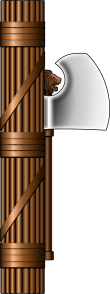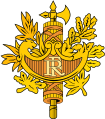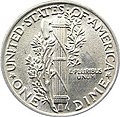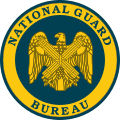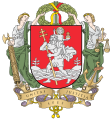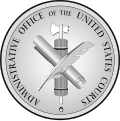Fascis
The Fasces ( Latin fascis, is m . : bundle, usually plural fasces ) are several rods in a bundle with a hatchet . In antiquity, Fasces were the official symbol of the highest rulers among the Etruscans and later in the Roman Empire . The bundles of rods were carried forward by their officials ( lictors ), which is why they are also called lictors' bundles . More recently, the symbol is used in states that want to establish a reference to the Roman Empire, such as the United States of America , France , but also fascist Italy used this symbol of power.
One possible interpretation could be the symbolism that a single stick is easier to break than a bundle of sticks. The ax symbolized the death penalty , which could be ordered by the officials.
Etruscan origins
The bundle of rods with an ax has been documented since the beginning of Etruscan history. In a grave near Vetulonia (Etruscan Vatluna ) one found such a bundle of rods on a reduced scale as a dedication. The artifact is made of iron and dates from the 7th century BC. The attached hatchet is a double ax.
The fasces as attributes of power are also described by the ancient authors as specifically Etruscan. According to Silius Italicus , a poet from the time of the Flavians , the bundle of rods was developed in Vetulonia. The servants carrying bundles of rods were among the Etruscan rulers' insignia as well as the scepter , the embroidered toga (toga praetexta) and a ruler's chair (sella curulis) . The ax already had a political and religious character in the Mediterranean cultures of Crete and Sardinia . The Mediterranean cultural currents brought the double ax as an attribute of power to archaic Italy, where the ax became a weapon and a symbol of the leader.
Roman adaptation
The Romans inherited numerous cultural achievements from the Etruscans, including many ceremonial customs and external attributes of rulership. The Fasces were first given to the Roman kings , after their expulsion then to the officials of the republic endowed with empire , i.e. v. a. Consuls , praetors and dictators . The promagistrates, former consuls or praetors acting as governors, also ran the Fasces. During a triumphal procession , distinguished members of his army also carried the fasces to the triumphant general. This use remained in the principate , which left the republican offices untouched.
The original task of the lictors was to clear the way for the officials. They also used crops to assert themselves among the onlookers. The whips were later connected to a bundle of rods with a leather strap.
Since the beginning of the republic, Roman citizens could not simply be sentenced to death or could appeal to the people against judgments by the official. For this reason, the consuls only had the axes inserted outside the Roman city limits . A special case, however, is the dictator who, as a sign of his unlimited power, also led the fasces with an ax inserted within the city limits. The number of fasces carried before the respective office holder expressed his rank. If the consuls wielded twelve bundles of rods, only six fasces were carried before a praetor. A dictator, on the other hand, carried 24 bundles of rods.
Use in Italian fascism

Mostly it is assumed that the term " fascism " (it. Fascismo ) has been derived from the term of the Fasces. However, a direct connection between the two terms is not visible. The term fasci was used in Italian politics as early as the late 19th century, but primarily by socialists, syndicalists and republicans . The agricultural workers' associations fasci dei lavoratori or fasci siciliani , founded as a kind of extra-parliamentary opposition, were evidently the originators of this term.
The symbol already appears as the logo of the workers' newspaper It must be day! in the year of the March Revolution, 1848. Furthermore, the fasces seem to have appeared in the parliamentary elections on November 11, 1919. Only later were they chosen to be the party badge of the Partito Nazionale Fascista . Benito Mussolini wanted to build on the glory and glamor of the Roman Empire in his imagery and chose the symbol of the lictors for his political movement . He himself later explained: Fascism demands “discipline and an authority that penetrates into the spirits and reigns therein undisputedly. His symbol is therefore the bundle of lictors, the symbol of unity, strength and justice ”. From December 30, 1926 the Fasces became part of the royal Italian coat of arms. During the Second World War, the Fasces were also the national emblem on the aircraft of the Italian Air Force.
The Bolzano Victory Monument from the time of fascism (erected in 1926/28 by Marcello Piacentini with the list of pillars formulated there ) and the badge of the Italian division of the Waffen-SS also led the Fasces.
- Illustrations
Flag of the Partito Nazionale Fascista
National coat of arms of the fascist Italian Social Republic 1943–1945
Coat of arms of Italian Libya 1934–1943
Coat of arms of the Kingdom of Albania as the protectorate of fascist Italy 1939–1943
Coat of arms of the Legione SS Italiana
Today's use in symbolism

The current national emblem of France , the Spanish Guardia Civil , the coat of arms of the Swiss canton of St. Gallen and the national coat of arms of Cameroon show a bundle of lictors, partly covered. The coat of arms of Ecuador , which is also used on the national flag , shows a bundle of rods.
In the United States, the symbol is often used, including a. the seal of the United States Senate and the seal of the National Guard Bureau with two bundles of lictors crossed. It can also be found several times at the feet (in the plinth, which cannot be seen by pedestrians in front of the building) of the Statue of Liberty that adorns the dome of the Washington Capitol and also to the left and right of the lectern in the US House of Representatives .
- Illustrations
Bundle of rods with hatchet in the coat of arms of the canton of St. Gallen
Bundles of rods on the armrests of the Lincoln Memorial
Seal of the United States Senate since 1876
Reverse of the 10 cent coin ("Mercury" dime)
Legau coat of arms
Seal of the National Guard Bureau
Civil Guard emblem
Tolochenaz coat of arms
Ühlingen-Birkendorf coat of arms
Vilnius coat of arms
The coat of arms of Cardinal Mazarins (1602–1661)
Individual evidence
- ↑ Jacques Heurgon : The Etruscans. 4th edition. Reclam, Stuttgart 1993, ISBN 3150104009 , p. 66.
- ↑ Silius Italicus, Punica VIII, 483 ff.
- ^ Massimo Pallottino : Etruscology: History and culture of the Etruscans. 7th edition, Springer, Basel 1988, ISBN 303486048X , pp. 297-298.
- ^ Sven Reichardt : Principles and Practice of Organizations . In: Fascist combat leagues. Violence and community in Italian squadrism and in the German SA. Böhlau, Cologne / Weimar / Vienna, 2nd revised edition 2009. ISBN 978-3-412-13101-2 .
- ^ Grazia Ambrosio: Le origini proletarie del fascio littorio. In: Storia Illustrata. No. 333, August 1985, ZDB -ID 1256702-4 , p. 125.
- ^ Gert Buchheit : Mussolini and the new Italy. Neff, Berlin 1938, p. 106.
- ^ Arnold Rabbow: dtv lexicon of political symbols. A-Z (= dtv 3084). Deutscher Taschenbuch-Verlag, Munich 1970, p. 77.
- ↑ Sabrina Michielli, Hannes Obermair (Red.): BZ '18 –'45: one monument, one city, two dictatorships. Accompanying volume for the documentation exhibition in the Bolzano Victory Monument . Folio Verlag, Vienna-Bozen 2016, ISBN 978-3-85256-713-6 , p. 89 and 95 (with ill.) .
literature
- Antje Middeldorf-Kosegarten : Fasces . In: Real Lexicon on German Art History . Volume 7: Paint, Colorants - Shutters. Beck, Munich 1981, ISBN 3-406-14007-6 , Sp. 461-496.
Web links
- Jona Lendering: Fasces . In: Livius.org (English)
